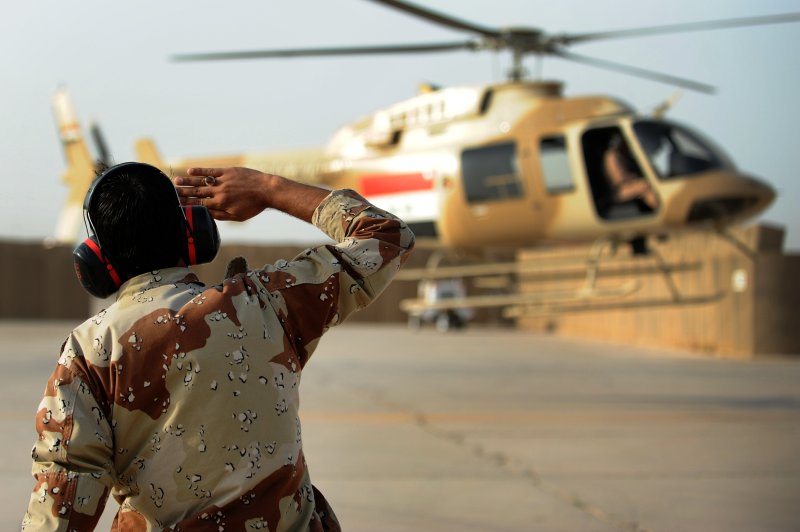With less than six months remaining before the U.S. withdraws from Iraq, U.S. military air advisors here are doubling their training efforts to ensure Iraqi Airmen are prepared to defend their boarders from the sky.
Air Force and Army pilots and maintainers from the 721st Air Expeditionary Advisory Squadron are training Iraqi Army Aviation Command airmen to maintain and operate the Bell 407 helicopter to ensure they can train future Iraqi airmen as the deadline for the U.S. to withdraw nears.
“The real goal is to make sure that when we leave they can (reproduce) that training and that they can continue to create qualified pilots,” said Army Maj. Kevin Ferner, Bell 407 helicopter instructor pilot and air advisor from the 721st AEAS.
The advisory team has trained and qualified more than fifty percent of the Iraqi airmen currently in the pilot training program. They are training them during the day, and at night using night vision goggles. Some of the more advanced pilots are training with ground forces conducting information, surveillance and reconnaissance operations.
“We are helping them jump start their training program as much as they can, but they’ll have to be able to maintain it,” Ferner said. “If they can maintain their level of training when we leave, even if they dip a little, then that’s a success. If they can do better than what they are doing now, then super.”
According to the major, learning to fly the Bell 407 helicopters is akin to driving a high performance racecar because everything is done manually, requiring the pilot to use the full range of human sensory. Many larger, more complex helicopters employ automatic flight stabilization controls not present on the Bell model. The four-blade, single-engine, civil utility helicopter requires the pilot to possess a honed ability to sense what the aircraft is doing.
“Stability augmentation systems assist pilots in all aspects of flight providing a great benefit to the pilot,” the major said. “However, for pilots to learn to fly without any of these enhancements requires and challenges them to truly fly. There are no automatic inputs, just the ones they make. They feel all the effects of the wind, acceleration, trim and power adjustments — they truly learn to fly.”
The Bell 407 is typically used by civilian and government agencies for corporate and offshore transport, air ambulance, law enforcement, news gathering and even movie making. Similar to their civilian and government counterpart uses, the IqAF will use the helicopter to patrol the Iraqi skies and U.S. air advisors have confidence that once they leave, the helicopters will be in good hands.
“The (new) lieutenants are excellent; they are like sponges, soaking up anything you can give them academically,” Ferner said. “They are even disappointed when they disappoint (the advisors). The lieutenants do believe they can make a change and it shows. They come prepared to train and they are fun to fly with.”
The Iraqi pilots are certainly the eyes on target when it comes to defending Iraq, but the pilots are only part of the equation. A team of qualified and motivated aircraft maintainers are also needed to ensure mission success. Tech. Sgt. Ryan Potter, a CV-22 Osprey crew chief and Bell 407 helicopter maintenance advisor, is working daily with the enlisted IqAAC airmen who are responsible for maintaining the aircraft Iraqi pilots rely on every day.
“The success of the Bell 407 mission depends, to a great extent, on the skills and expertise of the maintenance team,” said Potter, deployed from the 1st Special Operation Maintenance Operations Squadron at Hurlburt Field, Fla.
It has been less than eight months since the squadron took possession of the airframe. Potter believes in the short amount of time the squadron has been flying the Bell, the Iraqi maintainers have transformed into what he describes as being any other well trained and motivated maintainer found on an American flightline.
“Right now, they are demonstrating that they have the capacity to be great maintainers,” Potter said. “When they are asked to do something, they ask no questions and make no complaints, they get out there and do it. They are extremely capable people that have a ton of motivation and it’s just what Iraqi Air Force needs as they rebuild their air force.”
Beginning early next year, the IqAAC will acquire 24 Bell 407 helicopters with new armament capabilities, to be added to the three training models they already own. As the clock continues to tick down toward the exit of U.S. forces, U.S. advisors continue to be committed to helping train the Iraqi aviators with the necessary skills to carry on.









